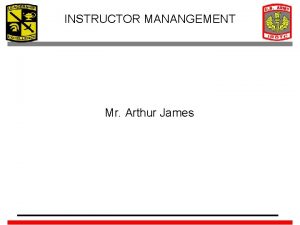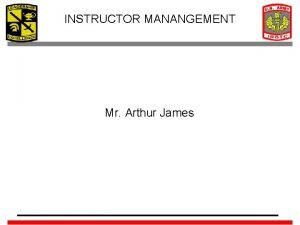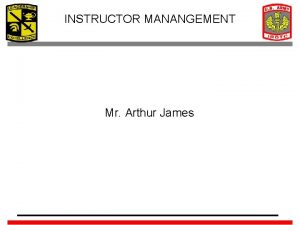Introduction to MS Project 2007 TUTORIAL 7 INSTRUCTOR















- Slides: 15

Introduction to MS Project 2007 TUTORIAL 7 INSTRUCTOR: HANIF ULLAH EMAIL ID: hanif. ksu@hotmail. com OFFICE #: 2029 DATE: 08/04/2012

Setting Task Constraints 2 �In this exercise, you apply a Start No Earlier Than constraint to a task. �Select the name of task 20, Develop prototype based on functional specifications. �On the Standard toolbar, click Task Information. �In the Task Information dialog box, click the Advanced tab. �In the Constraint Type box, select Start No Earlier Than. �In the Constraint Date box, type or select 08/03/12 �Click OK �Project applies a Start No Earlier Than (SNET) constraint to the task, and a constraint icon appears in the Indicators column.

Setting Task Constraints 3 � Task 20 is rescheduled to start on March 08 instead of March 06. All tasks that depend on task 20 are also rescheduled. � Click the Close button (the “X” button in the upper right corner) on the Task Drivers pane. � Here a few other things to keep in mind when applying constraints to tasks: � Entering a Finish date for a task (for example, in the Finish column) applies a Finish No Earlier Than (FNET) constraint to the task. � Entering a Start date for a task (for example, in the Start column) or dragging a Gantt bar directly on the Gantt chart applies a Start No Earlier Than (SNET) constraint to the task. � In many cases, entering a deadline date is a preferable alternative to entering a semi-flexible or inflexible constraint.

Viewing the Project’s Critical Path 4 �A critical path is the series of tasks that will push out the project’s end date if the tasks are delayed. �In this exercise, you view the project’s critical path. One way to see the critical path is to switch to the Detail Gantt view. �On the View menu, click More Views. �In the More Views dialog box, select Detail Gantt, and then click the Apply button. �The project appears in the Detail Gantt view. �On the Edit menu, click Go To. �In the ID box, type 12, and then click OK. �On the View menu, click Gantt Chart

Interrupting Work on a Task 5 � You can split the task to indicate times when the work will be interrupted and when it can resume. � In this exercise, you split a task to account for a planned interruption of work on that task. � On the Edit menu, click Go To. � 2. In the ID box, type 8, and then click OK. � Project displays task 8. � On the Standard toolbar, click the Split Task button. � A Screen. Tip appears, and the mouse pointer changes. � Move the mouse pointer over the Gantt bar of task 8 � Move (but don’t click) the mouse pointer over the Gantt bar of task 8 until the start date appears in the Screen. Tip. � Project inserts a task split, represented in the Gantt chart as a dotted line, between the two segments of the task

Interrupting Work on a Task 6 �Here a few other things to keep in mind when splitting tasks: �You can split a task into as many segments as you want. �You can drag a segment of a split task either left or right to reschedule the split. �The time of the task split, represented by the dotted line, is not counted in the duration of the task. No work occurs during the split. �If the duration of a split task changes, the last segment of the task is increased or decreased. �If a split task is rescheduled (for example, if its start date changes), the entire task is rescheduled, splits and all. The task keeps the same pattern of segments and splits. �To rejoin two segments of a split task, drag one segment of the task until it touches the other segment.

Entering Deadline Dates 7 �Entering a deadline date causes Project to display a deadline indicator on the chart portion of the Gantt Chart view. �In this exercise, you enter deadline dates for some tasks. �On the Edit menu, click Go To. �In the ID box, type 16 and click OK. �On the Standard Toolbar, click Task Information. �Click the Advanced tab. �In the Deadline box, type or select 24/02/12, and then click OK. �Project inserts a deadline indicator in the chart portion of the Gantt Chart view.

Setting Up a Recurring Task 8 �Many projects require repetitive tasks, such as attending project status meetings, creating and publishing status reports, or running quality-control inspections. �a recurring task is repeated at a specified frequency such as daily, weekly, monthly, or yearly. �In this exercise, you create a recurring task that will represent a weekly meeting associated with this project. �On the View menu, click Gantt Chart. �The Gantt Chart view appears. � 2. Select the name of task 16, Analysis complete �On the Insert menu, click Recurring Task.

Setting Up a Recurring Task 9 � The Recurring Task Information dialog box appears. � In the Task Name box, type Staff planning meeting � In the Duration box, type 2 h � Under Recurrence pattern, make sure Weekly is selected, and then select the Monday check box. � Next, you will specify the date of its first occurrence. By default, it is the project start date. However, you want the weekly status meetings to begin one week later. � In the Start box, type or select 08/02/12. � Next, you will specify the number of recurrences. You do this by entering either an exact number of recurrences or a date by which the task should end. � Select End after, and type or select 10 occurrences. � Click OK to create the recurring task � Project inserts the recurring tasks

Setting Up a Recurring Task 10 �Next, you will assign resources to the recurring task. �Verify that task 17, Staff planning meeting, is selected, and then, on the Standard toolbar, click Assign Resources. �In the Assign Resources dialog box, click Resource 1. Then hold down the Ctrl key while clicking Resource 2 and resource 3. � 13. Click the Assign button, and then click Close. �The Assign Resources dialog box closes, and Project assigns the selected resources to the recurring task. Next, you will view the individual occurrences of the recurring task. �Click the plus sign next to the recurring task’s title, Staff planning meeting. �Click the minus sign next to the recurring task’s title, Staff planning meeting, to hide the individual occurrences

Examining Resource Allocations over Time 11 �In this exercise, you will focus on resource allocation- how the task assignments you’ve made affect the workloads of the work resources (people and equipment) of a project. The relationship between a resource’s capacity and his or her task assignments is called allocation. Each work resource is in one of three states of allocation: �Underallocated The resource’s assignments do not fill the resource’s maximum capacity. For example, a fulltime resource who has only 25 hours of work assigned in a 40 -hour work week is underallocated.

Examining Resource Allocations over Time 12 �Fully allocated The resource’s assignments fill the resource’s maximum capacity. For example, a fulltime resource who has 40 hours of work assigned in a 40 -hour work week is fully allocated. �Overallocated The resource’s assignments exceed the resource’s maximum capacity. For example, a fulltime resource who has 65 hours of work assigned in a 40 -hour work week is overallocated �In this exercise, you look at resource allocations and focus on two resources who are overallocated.

Examining Resource Allocations over Time 13 �On the View menu, click More Views, click Resource Allocation, and then click the Apply button. �The Resource Allocation view appears. This is a split view, with the Resource Usage view on top and the Leveling Gantt Chart view on the bottom. �On the left side of the Resource Usage view is a table (the Usage table, by default) that shows assignments grouped per resource, the total work assigned to each resource, and each assignment’s work. �The right side of the view contains assignment details (work, by default) arranged on a timescale. �The bottom pane shows the Leveling Gantt Chart view only for whatever resource or assignment (single or multiple) is selected in the upper pane.

Examining Resource Allocations over Time 14 � On the Standard toolbar, click the Scroll To Task button � Click the Resource Name column heading. � On the Project menu, point to Outline and then click Hide Assignments � Next, you will look at two work resources and their allocations. � 7. In the Resource Name column, click the name of resource 4. � 8. On the Standard toolbar, click Scroll To Task. � Point to the W column heading (for Wednesday) at the top of the timescaled grid. � A Screen. Tip appears with the date of the assignment: � On the Format menu, click Timescale. � Make sure that the Middle Tier tab is selected, and in the Units box under Middle tier formatting, click Months. � In the Show box under Timescale options, click One tier (Middle). Click OK to close the Timescale dialog box.

15 END of Tutorial 6
 Microsoft project 2007 tutorial
Microsoft project 2007 tutorial Microsoft project tutorial 2007
Microsoft project tutorial 2007 Microsoft project 2007
Microsoft project 2007 Project server 2007
Project server 2007 Microsoft project 2003
Microsoft project 2003 Advantages of ms word 2007
Advantages of ms word 2007 Tipos de participantes en una capacitación
Tipos de participantes en una capacitación Tcole instructor course
Tcole instructor course Basic instructor course texas
Basic instructor course texas Basic instructor course texas
Basic instructor course texas Pepperball launcher nomenclature
Pepperball launcher nomenclature Everyone selected to serve on this jury
Everyone selected to serve on this jury Instructor vs teacher
Instructor vs teacher Ospfv
Ospfv Mptc firearms instructor manual
Mptc firearms instructor manual Basic instructor course texas
Basic instructor course texas


























